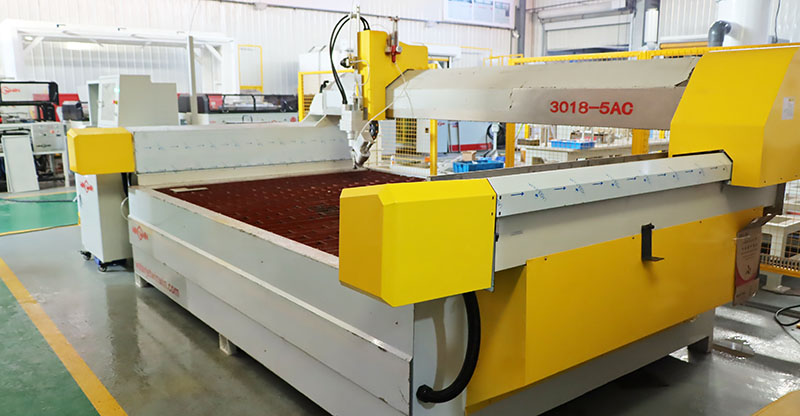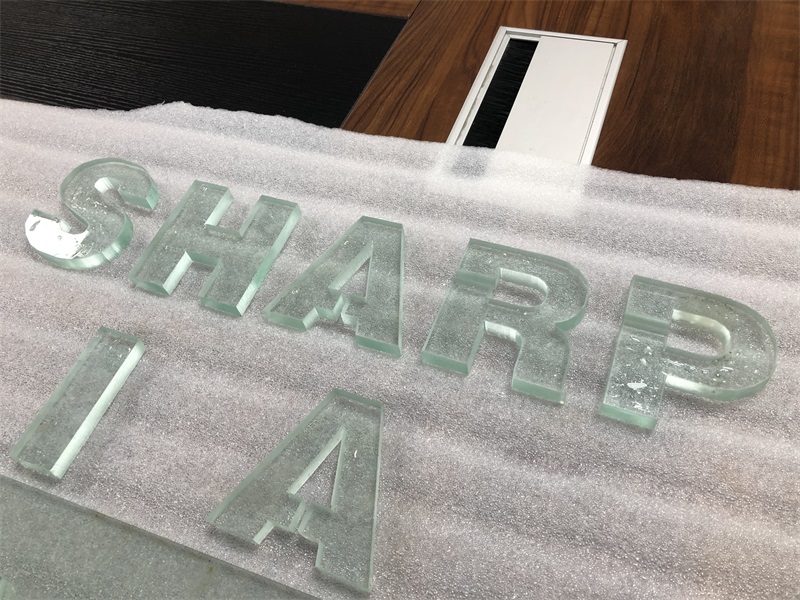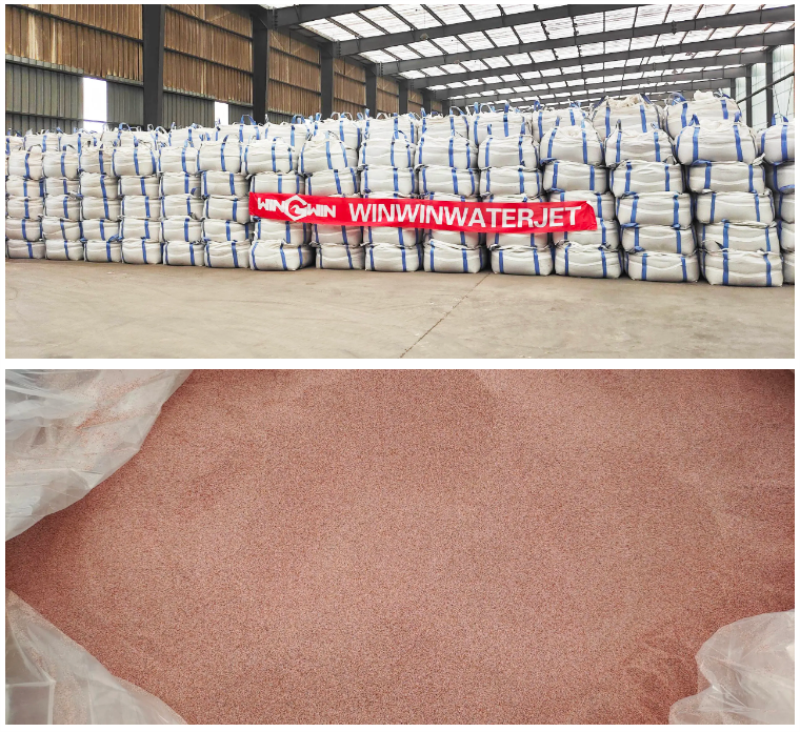waterjet cutters are widely used in glass cutting. Waterjet cutting is a good way for cutting glass because it offers many advantages over other cutting methods. For example, waterjet cutting does not produce heat, which means there is no risk of thermal damage to the glass. This is particularly important for cutting fragile or delicate glass, such as stained glass or tempered glass. In addition, waterjet cutting offers high precision and accuracy, which is essential for cutting intricate shapes and designs in glass. Waterjet cutting can also be used to cut a variety of glass thicknesses, from thin sheets to thicker pieces. Waterjet cutting is used in a variety of glass cutting applications, including architectural glass, automotive glass, and decorative glass. It is also used for cutting glass for artistic purposes, such as creating glass sculptures or glass mosaics.

There are several advantages to cutting glass with a waterjet machine, including: Precision: Waterjet cutting is a highly precise cutting method that can cut intricate shapes and designs with great accuracy. This is particularly important for glass cutting, where precision is crucial to achieving the desired outcome. No heat-affected zone: Waterjet cutting only produce wate and garnet, which means there is no heat-affected zone (HAZ). This is key for cutting glass, as heat can cause the glass to break or shatter. No dust: Waterjet cutting does not produce any dust or other particles, which means there is no need for additional cleaning or filtering equipment. This is particularly important for cutting glass, which can be easily scratched or damaged by dust particles.
Versatility: Waterjet cutting can be used to cut a wide range of materials, marble, glass, metal, stone, and tiles. This makes it a versatile cutting method that can be used for a variety of materials.
Reduced waste: Waterjet cutting produces less waste than other cutting methods, as it produces a narrow kerf and can cut very close to the material's edge. which means that less material is wasted, which can result in cost savings over time.
Cutting glass with a water jet requires specific techniques and equipment to ensure a clean and perfect cut. Here are some of the proper techniques and equipment for cutting glass with a water jet:
Use the Right Nozzle and Abrasive When cutting glass with a water jet machine, it is essential to use the right orifice and abrasive. The nozzle should be selected based on the thickness of the glass and the desired speed and accuracy of the cut. The most common nozzle sizes for cutting glass are 0.010 inch and 0.014 inch. The abrasive material used in the cutting process should also be selected carefully to prevent damage to the glass. Crushed garnet is the most common abrasive material used for cutting glass with a water jet.
Adjust the Water Pressure and Flow The water pressure and flow rate must be adjusted carefully when cutting glass with a water jet. The pressure should be set to a level that is appropriate for the thickness of the glass, and the flow rate should be adjusted to ensure that the abrasive is evenly distributed across the surface of the glass. The pressure and flow rate can be adjusted using the water jet cutting machine's control panel.
Secure the Glass
The glass must be held securely during the cutting process to prevent it from shifting or vibrating, which can cause the cut to be inaccurate or uneven. The glass can be secured using a vacuum table, a clamping system, or other similar methods.
Use a Protective Coating
A protective coatingcan be applied to the surface of the glass before cutting to prevent scratches and other damage. The coating can be a thin layer of plastic film or a specialized protective coating that is designed specifically for water jet cutting. The coating should be applied evenly and allowed to dry before the cutting process begins.
Use Proper Cutting Speed and Techniques
The cutting speed and techniques used for cutting glass with a water jet depend on the thickness of the glass and the desired accuracy of the cut. Generally, slower cutting speeds are used for thicker glass, while faster speeds are used for thinner glass. In addition, the cutting techniques should be adjusted to ensure that the cut is smooth and accurate. example, a back-and-forth motion can be used to make a straight cut, while a circular motion can be used to make a curved cut.
Clean the Cut Edge
After the cutting process is complete, the cut edge of the glass should be cleaned to remove any residual abrasive material or debris. This can be done using a specialized cleaning tool or by gently wiping the edge with a clean cloth. In conclusion, cutting glass with a water jet requires specific techniques and equipment to ensure a clean and accurate cut. These techniques include using the right nozzle and abrasive, adjusting the water pressure and flow, securing the glass, using a protective coating, using proper cutting speed and techniques, and cleaning the cut edge. It is important to consult with a water jet cutting expert before attempting to cut glass with a water jet to ensurea safe and accurate cutting process. By following these proper techniques and equipment, water jet cutting can be a highly effective method for cutting glass, providing precise and clean results without damaging the delicate material.

Waterjet cutting can cut most types of glass, including tempered glass, laminated glass, and annealed glass. However, there are some types of glass that may be more difficult to cut with waterjet cutting, such as borosilicate glass or glass that is highly curved or uneven. When cutting glass with a waterjet, need to use the appropriate cutting system and techniques to ensure a perfect, precise cut. For example, the water pressure, nozzle size, and cutting speed may need to be adjusted depending on the thickness and type of glass being cut. It is also important to consider the potential for cracking or chipping when cutting glass with a waterjet. To minimize the risk of damage, the glass may need to be supported or clamped securely during the cutting process. Waterjet cutting can cut glass of various thicknesses, depending on the waterjet cutting machine's power and the type of cutting head used. Generally speaking, waterjet cutting machines can cut glass up to several inches thick. However, the thickness of the glass also depend on other factors, such as the type of glass being cut and the cutting speed. For example, thicker glass may require a slower cutting speed to achieve a clean and precise cut. It is also important to note that cutting thicker glass may require additional support or clamping to prevent the glass from cracking or breaking during the cutting process. In some cases, it may be necessary to use specialized cutting techniques or equipment to cut thicker glass with a waterjet.

While waterjet cutting is an effective and versatile method for cutting glass, there are some potential disadvantages to using this cutting method. Some of the disadvantages of waterjet cutting glass include:
Cost: Waterjet cutting machines can be expensive to purchase and operate, making this cutting method more costly than some other cutting methods.
Speed: Waterjet cutting may not be as fast as other cutting methods, particularly when cutting thicker glass. This can result in longer cutting times and may limit the production capacity of a manufacturing facility.
Edge quality: Waterjet cutting can produce a slightly rough edge on the cut surface of the glass, which may require additional finishing or polishing to achieve a smooth, polished edge. Maintenance: Waterjet cutting machines require regular maintenance to ensure optimal performance, including maintenance of the high-pressure pump, cutting head, and other components. Environmental impact: Water jet cutting uses a significant amount of water, which can be a concern in areas with water scarcity or where wastewater treatment is a concern.
 wwaterjet
wwaterjet